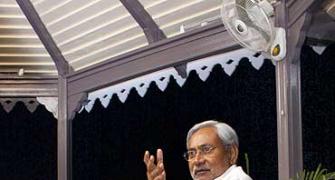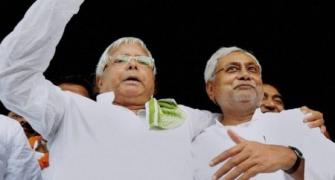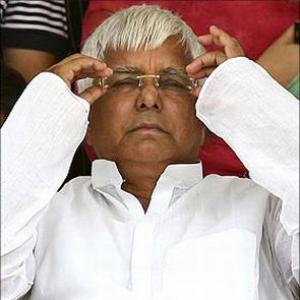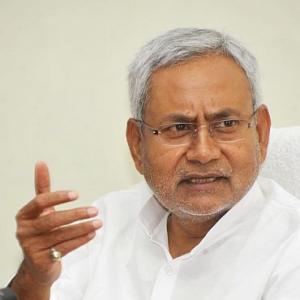If Nitish Kumar along with the Congress presents a combative spirit to take on Narendra Modi, then, Lalu calculated, his Muslim-Yadav combination will weaken if a large chunk of Muslims shifts to the stronger fighter who can take on Modi.
That is why Lalu said that he was ready to “drink poison" to crush the "cobra" of communalism.
Lalu and many other leaders believe that if Bihar is won by the BJP it will have a cascading effect, from Assam to Punjab, in the next two years, which will give it a comfortable decade to spread its ideology like never before.
Political compulsions thus forced Lalu to support Nitish Kumar, who is seen to be in a better position to defeat the BJP.
Sheela Bhatt/Rediff.com explains the compulsions that forced Bihar strongman Lalu Yadav to play second fiddle to Nitish Kumar.

Lalu Prasad Yadav’s decision to agree to Nitish Kumar as the chief ministerial candidate of the Janata Dal-United and Rashtriya Janata Dal combine in Bihar is that rare political moment which can bring about a sea-change in Bihar politics -- and in national politics -- if it culminates in its stated goal of stopping the Bharatiya Janata Party from coming to power in Patna.
After repeating his rhetoric for weeks on end, Lalu, while beating a retreat in the high stakes game, said, “Hum har tarah ki zehar peene ko taiyaar hain (I am ready to drink any kind of poison)” for the sake of secularism.
Multiple sources in Bihar and New Delhi, who were privy to the intriguing process by which Lalu was explained, forced to understand and accept why he should declare his support to Nitish, said the former chief minister was left with no other political choice.
In order to survive in the long term, he had to concede the demands of the JD-U and Congress party. If the BJP came to power in Bihar, his party's short term and long term politics would be at grave risk, but if he unites the anti-BJP forces in Bihar today, he can survive to fight another day.
Lalu and many other leaders believe that if Bihar is won by the BJP it will have a cascading effect, from Assam to Punjab, in the next two years, which will give it a comfortable decade to spread its ideology like never before.
Political compulsions forced Lalu to support Nitish Kumar, who is seen to be in a better position to defeat the BJP.
Lalu is facing charges in a court case and is unable to fight himself due to his legal troubles. His proxy like Rabri Devi or any of his son or daughters are not as big and powerful a personality as Nitish Kumar. In the given circumstances, the chorus “ to defeat the BJP” is so shrill that Lalu could foresee that he just cannot be seen to be helping the BJP even by default.
Lalu has credibility as a “secular fighter” among Bihar’s Muslims. To retain his Muslim vote bank he saw that merely chanting rhetoric won't do anymore. There was no way he could have escaped the allegation that his denial of support to Nitish Kumar helped the BJP. Nitish Kumar's strident and consistent anti-Modi politics has helped him reach a position that even Lalu was forced to endorse him.
Lalu Yadav’s “secular” image is not tainted, and he remains an able opponent of the BJP’s politics. In the eyes of Bihar's Muslims Lalu certainly packs more credibility than Nitish Kumar, his political rival of decades.
With Prime Minister Narendra Modi and BJP president Amit Shah moving ahead in different states with their combative political management, it is more than clear that the “secular-communal” issue will remain relevant in Bihar’s assembly elections. Lalu’s party has Muslim and Yadav (M-Y) votes which made his career and gave him the power to rule Bihar for more than seven years. Muslims form 16.5 per cent of Bihar’s electorate while Yadavs constitute about 14 per cent. Currently, Lalu’ party has 22 legislators.
A few days back, some 11 of his party MLAs met Lalu’s wife Rabri Devi to convey to him, who was camping in Delhi, to accept Nitish as the CM candidate. The Muslim voters in Bihar, like elsewhere, are likely to vote for the candidate most likely to defeat the BJP.
In spite of having a secure voter base of 30.5 pc, Lalu was under tremendous pressure to give up the CM’s claim. Prem Gupta, Lalu’s confidant of many decades and a former minister, was pressurising him to not surrender to Nitish Kumar who will gain more out of the alliance than Lalu or his party. This is somewhat true, too.
Lalu’s Yadav vote-bank is still largely with Lalu and it is largely accepted that the Muslims’ first choice in Bihar is the RJD. But, if Lalu was not the CM candidate and the RJD was not emerging as the fittest party to fight the BJP, then the Muslim vote will get divided among the JD-U, Congress and RJD.
Prem Gupta’s son Gaurav has been facing, since long, an investigation into the allotment of coal blocks in Maharashtra. The investigation is related to the submission of certain data on the basis of which the coal block was allotted during the United Progressive Alliance regime.
Another mining baron with a huge interest in the energy sector is also pressuring the RJD’s leadership against a merger with the JD-U. Thus Lalu delayed the decision to declare his support to Nitish, but eventually he took a purely political decision.
Some of his party leaders feared that if Lalu became a stumbling block to the secular front, then in no time the JD-U and Congress would allege that it was the fear of his pending court cases and Prem Gupta’s pressure on him that prevented Lalu from going in for a historic political realignment that would strengthen the secular pole in Bihar to take on Modi.
Also, rumours of the National Democratic Alliance government's alleged pressure to thwart the formidable RJD-JD-U and Congress alliance would have hurt Lalu more than anybody else.
For now Lalu has cut his losses to retain claim to the hardcore secular plank.
On Monday, after the major announcement, a senior Congress leader told Rediff.com, “Lalu seems uncertain. He can break his commitment at the time of ticket distribution or soon after the election.”
Already, in closed-door negotiations, Lalu wants a seat-sharing formula on the basis of the 2014 Lok Sabha election results while Nitish wants it on the basis of the 2010 assembly election results.
In the last assembly election the RJD got 18.84 pc of the vote but just 22 seats while JD-U got 22.61 pc of the vote but managed to win 112 seats. Its alliance with the BJP helped it win power. The Congress managed to win 8.38 pc votes and just four seats.
In the last Lok Sabha election the JD-U got 15.80 pc of the vote but won only two seats while Lalu’s party got 20.10 pc of the vote and won four seats. Obviously, Lalu wants a seat-sharing formula on the basis of the more favourable Lok Sabha election results. If compared to JD-U it is Lalu's party which is witnessing a surge in people's support.
Some senior Congressmen, in off-the-record conversations, feel that there may be “hidden considerations” behind Lalu’s moves because he is not someone who will willingly take the back seat. They say if Lalu means what he says before TV cameras (about sacrificing power for the sake of secularism), then it is clear the BJP is at a huge disadvantage.
Lalu may have bought time to avoid the huge pressure that came from Mulayam Singh Yadav, JD-U, his own MLAs and the Congress.
Nobody has any doubt about Lalu’s potential, and it is likely the RJD may have a better strike rate than Nitish’s JD-U.
“In case, after the assembly election, the RJD has more MLAs than the JD-U and if the secular front is in a position to form the government, then Nitish Kumar will not be supported by Lalu in the post-poll scenario,” says a senior Congress leader.
He explained that in the last few elections Lalu outsmarted the Congress before the election campaign by forging a regional alliance in Patna before coming to New Delhi to negotiate with the Congress. In the 2010 election, before he met Congress leaders in Delhi, he had sealed an alliance with Ram Vilas Paswan and used their combined strength as a bargaining chip. But now Nitish Kumar and Congress have outsmarted Lalu, doing a Lalu on him.
In between the hectic negotiations the Congress had sent Ghulam Nabi Azad to Patna to assess the ground situation there. After getting an idea of the political buzz in Patna, Rahul Gandhi met Nitish Kumar in Delhi to assure the latter of support for his CM candidature. He also ensured that Sonia and Lalu’s meeting took place only after he announced his support to Nitish. Once Nitish and Rahul Gandhi’s meeting was made public, Lalu had no option but declare his support as well.
Traditionally, Yadav leaders in Bihar don’t like Nitish Kumar’s politics, as he belongs to the Kurmi caste, but if Nitish along with the Congress presents a combative spirit to take on Modi, then, Lalu calculated, his M-Y combination will weaken if a large chunk of Muslims shifts to the stronger fighter who can take on Modi.
That is why Lalu said that he was ready to “drink poison" to crush the "cobra" of communalism.
Samajwadi Party chief Mulayam Singh Yadav, who is now a relative of Lalu – the latter’s daughter Raj Laxmi is married to Mulayam’s grand-nephew Tej Pratap Yadav -- also explained to Lalu the need to agree as soon as possible.
Yadav, K C Tyagi and JD-U's Sharad Yadav held a major meeting in New Delhi to put pressure on Lalu, explaining to him that if he fought the election decently and won a respectable number of seats, he can “survive for another day”. "Bihar nikaal do, phir aage dekhenge" was the message to all from Mulayam Yadav.
Also, importantly, the role of the state government is important in Lalu’s legal woes.
In the Lok Sabha election of 2014, the NDA (BJP and Lok Janshakti Party) got 38.8 pc of the votes. And UPA (Lalu and Congress) got 28.5 pc, but with the JD-U’s shift with Lalu and Congress now their combined strength stands at 44.3 pc of votes. The difference in vote share is 5.5 pc in favour of the Nitish-led alliance.
If one goes by the 2010 assembly election then the combined strength of Congress, RJD and JD-U is 50 pc of votes polled while the BJP and the Paswan-led LJP’s strength remains at 23.21 pc .
Any which way the results of the 2010 assembly and 2014 Lok Sabha elections are seen, the combination of JD-U-RJD and Congress stands a better chance to fight Modi and the BJP.
It is true that the votes gained by the JD-U in 2010 and 2015 were in completely different circumstances but the Lalus of Indian politics can never give up their claim on the gaddi without smelling power or over the fear of the unknown.










